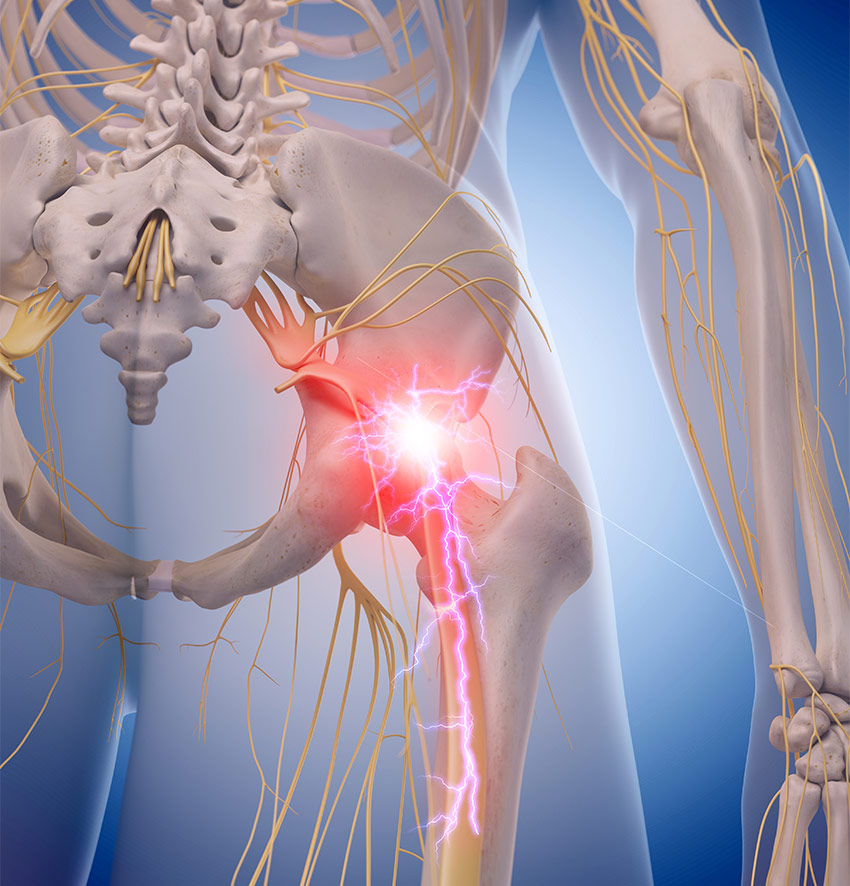What is Sciatic Nerve Pain?
Do you ever experience distressing pain all the way from your upper thighs to your feet? Do you find yourself having to deal with chronic lower back pain that spreads downwards through your pelvis and down your leg? That pain might actually be sciatic nerve pain.
Whether acute or chronic, sciatic nerve pain can become very problematic and distressing. But what exactly is sciatic nerve pain? And how can you deal with it? Here we’ll take a look at sciatic nerve pain and some common treatment options that may help provide some relief.
Sciatic Nerve Pain
According to Dr. Jeffrey N. Katz, professor of medicine and orthopedic surgery at Harvard Medical School.
“People who suffer from acute or chronic back pain tend to be more susceptible to sciatica.”
Your risk of suffering from sciatica also increases if you’re overweight, a smoker, or if you lead an inactive and sedentary lifestyle.
Sciatic nerve pain is among the most common and misunderstood types of pain. In fact, as many as 40% of people suffer from it at one point or another in their life. When left untreated, it can become more prevalent as you age.
Sciatic nerve pain is often is lumped together with chronic back pain, but it does have distinct differences. Sciatic nerve pain originates from the sciatic nerves. The sciatic nerves are the two biggest nerves in the human body (about as thick as your pinkie finger). The nerves originate from the lower lumbar spine and pass through the pelvis, down the back of your legs, to the soles of your feet and even your toes.
What are the Symptoms of Sciatic Nerve Pain?
Sciatic nerve pain occurs when the root that originates from one of the sciatic nerves, or the nerve fibers, becomes irritated or pinched. The resulting pain is experienced anywhere along the branch of the nerve, including the lower back, buttocks, legs, calves, feet, or toes.
According to the Mayo Clinic, no two sciatic pain episodes are alike. However, “pain that radiates from your lower (lumbar) spine to your buttock and down the back of your leg is the hallmark of sciatica.” Symptoms of sciatic nerve pain vary from patient to patient, but typically limited to only one side of your body.
- Mild sciatic nerve pain symptoms may include dull soreness, numbness, tingling feeling, mild aches and pains.
- Moderate sciatic nerve pain symptoms may include feelings of an electric shock, throbbing heat, or a stabbing pain.
- Severe sciatic nerve pain symptoms may include pain so intense it makes it difficult to walk or stand.
Treatment Options
Depending on the severity and duration of sciatic nerve pain, there are many treatment options available. Severe sciatic nerve pain attacks can persist for days, several weeks or even months. In which case, you should consult with your doctor about possible treatment options.
Commonly prescribed non-opioid medication treatments include: acetaminophen (Tylenol) and nonsteroidal anti-inflammatory drugs like ibuprofen (Motrin) and naproxen (Aleve). Ice Therapy may also be recommended, but in limited time frames: about 15 to 20 minutes during the first onset of pain symptoms. However, neither of these treatment options have been shown to provide long-lasting pain relief or rehabilitative benefits, and medications can come with additional negative side effects.
Another treatment option suggested may be for steroid injections, however they may not work for everyone. According to a study in the May 19, 2015, issue of The Journal of the American Medical Association (as cited by Harvard Medical School), research among 269 study participants with sciatica found that individuals who took a daily steroid for 15 days did not report major improvement in their pain compared to those individuals in the placebo group.
But what if you suffer from sciatic nerve pain and want to avoid medications all together?
Drug Free Pain Relief with H-Wave
H-Wave is a unique, scientifically proven method for relieving pain. Through electrical stimulation, the multi-functional H‑Wave device is designed to help manage chronic, acute or post-operative pain. It’s a non-invasive, drug-free alternative treatment option without harmful side effects. Research shows that 78% of individuals who use H‑Wave treatment reported significant pain reduction; and 65% of H‑Wave users reported a reduced or eliminated need for pain medication. In fact, the analgesic effect of H‑Wave treatment is so effective that the FDA has cleared the technology for dental anesthesia.
So, if you suffer from acute or chronic sciatic nerve pain, H-Wave may provide the relief you’ve been searching for without relying on medications. Contact a member of our team to learn more about whether or not H-Wave could be right for you.
You may also like: